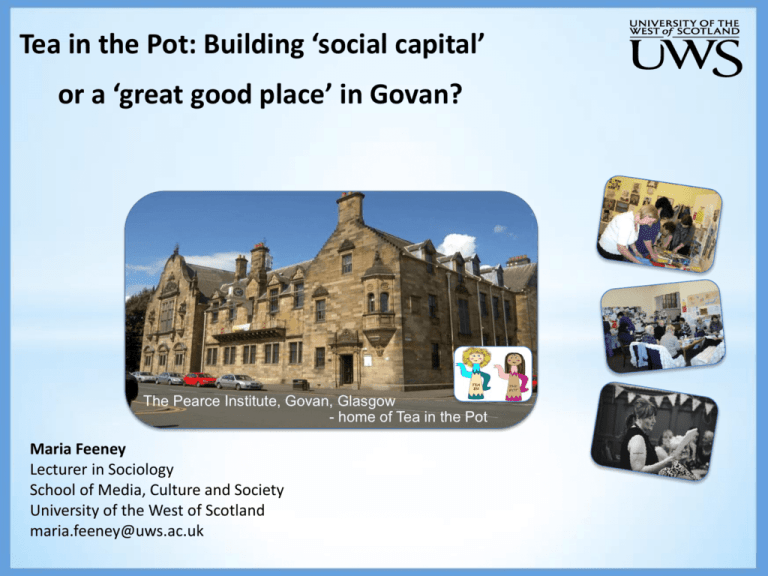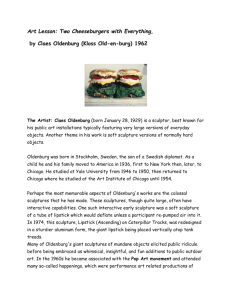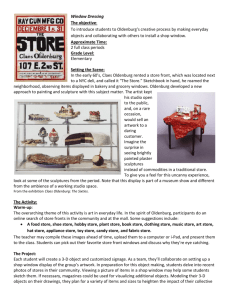Tea in the Pot as third place
advertisement

Tea in the Pot: Building ‘social capital’ or a ‘great good place’ in Govan? Maria Feeney Lecturer in Sociology School of Media, Culture and Society University of the West of Scotland maria.feeney@uws.ac.uk Introduction The concept of ‘social capital’ Using the language of social capital Empowering communities? Third place Tea in the Pot as a ‘third place’ – a ‘great good place’ Final words The concept of social capital The Organisation for Economic Co-Operation and Development (OECD) defines ‘social capital’ as networks together with shared norms, values and understandings that facilitate co-operation within or among groups (OECD 2001, p41) Term is at best vague and has multiple definitions Popularised by R Putnam (1996) – decentralised state coupled with a strong ‘civil society’ would lead to relations of reciprocity across society thus enabling the rational actions of individuals to benefit society as a whole Tied to a wider real world development – in which the state was further withdrawing from supporting people in communities damaged by deindustrialisation, unemployment and poverty Language of social capital The potential appeal of concept of ‘social capital’ to policy makers is clear – if people can be encouraged to build their social networks, this would aid the development of ‘healthy’ communities who would then place less demands on social services In recent decades, there has been similar language used around policies for deprived communities– for example, ‘social inclusion’ ‘partnership’, ‘community engagement’ vibrant communities’, ‘community empowerment’ and the like Although this language sound good, there has in fact been a sharpening of poverty and inequality, increased social exclusion and disempowerment Language and empowerment Language of social capital ‘responsibilises’ communities for problems not of their own making Leads to the kind of thinking where local communities are viewed as being in deficit, of somehow failing to help themselves and are often ‘abandoned’ to deal with their own problems Perhaps more positively, in the recently passed Community Empowerment (Scotland) Bill, much is said about what should be done to empower communities The Local Government and Regeneration Committee’s Stage One Report on the Bill stresses repeatedly the need for the terms which we invoke in talking about the problems of local communities to be intelligible and practically meaningful to the people in those communities (Feeney, M. & Collins, C. 2015) Third place With this in mind, we argue that policy makers should be looking for a more viable language that makes sense to, and resonates with, the lived experiences of the communities we are talking about and with To this end, the concept of ‘third place’ seems to us to begin to address the above issues Oldenburg (1989, 1999) identifies ‘third places’ as accessible spaces away from home and work (the first and second places) They are described as place which provide a sense of belonging and community and as key ‘anchors’ to the community for those who frequent them Tea in the Pot Research carried out with an Oxfam community partner group, Tea in the Pot (TITP) a Women’s Drop-In and Support Service based in Govan and founded in 2005 Drawing on the findings from focus groups, individual interviews and witness testimonies, we found that TITP can be viewed as an attempted to ‘improvise’ a ‘great good place’ in the heart of Govan Utilising Oldenburg’s work and the work of those who have employed the concept of third place, we found that the women at TITP understood and very quickly embraced Oldenburg’s terms Tea in the Pot as third place • Supporting positive social interaction • Engendering a sense of belonging • Reducing loneliness and isolation • Being part of a wider community • Making a difference (Feeney, M. & Collins, C. 2015) 1. neutral 2. non-hierarchical 3. interactive 4. accessible and accommodating 5. welcoming 6. ordinary 7. sociable 8. comfortable (Oldenburg 1999) Tea in the Pot as third place The language of third place connected in a meaningful way with the history of their own lives and their experience of how their community has changed They see as Oldenburg did in the US, that the processes of economic, social, political and urban change has undermined the existence of third places which are so important to the ‘vibrant communities’ which over the years policy makers have been keen to aspire to The women are very much aware of their own needs and those of the wider community and how these can be met, and have successfully been doing this for the last ten years with very limited resources Final Words In closing, it seems appropriate to leave the last words to the women of TITP as a way of demonstrating that they are only too well aware of what women in communities like Govan need to help them feel empowered, important, valuable “The health services will employ psychiatrists, psychologists and all the rest of it, your talking therapy. None of it is the same as coming (to TITP) and talking to people you trust, people you can relax with and really talk to” “You come to (TITP) for yourself, but after a while you, you’re involved with people and you have that sense that…it’s not all about you. You want to be helping other people” “It’s not just an exercise (coming to TITP), it not just like ‘ah well she didn’t quite like it’, ehm you’re kind of hunted, they track you down to make sure you are still breathing. It’s good, it sounds horrible, but it is a really, it’s a good feeling, it’s a kind of security blanket…it makes you feel kind of important” References Cheang, M. (2002). "Older adults’ frequent visits to a fast-food restaurant: Nonobligatory social interaction and the significance of play in a ‘‘third place’’." Journal of Aging Studies 16: 303-321. Feeney, M and C. Collins (2015) “Tea in the Pot: Building ‘social capital’ or a ‘great good place’ in Govan?” Paisley. UWS-Oxfam Partnership Report No. 3 L Glover, D. T. and D. C. Parry (2009). "A Third Place in the Everyday Lives of People Living with Cancer: Functions of Gilda's Club of Greater Toronto." Health and Place 15: 97-106. Hickman, P. (2010). Neighbourhood Infrastructure, ‘Third Places’ and Patterns of Social Interaction. Sheffield, Centre for Regional Economic and Social Research/Sheffield Hallam University. Hickman, P. (2013). ""Third places" and Social Interaction in Deprived Neighbourhoods in Great Britain." Journal of Housing and the Built Environment 28(2): 221-236. http://www.scottish.parliament.uk/S4_LocalGovernmentRegenerationCommittee/Reports/lgR-15-02w.pdf Meshram, K. and A. O'Cass (2013). "Empowering Senior Citizens via Third Places: Research Driven Model Development of Seniors' Empowerment and Social Engagement in Social Places." Journal of Services Marketing 27(2): 141-154. McGuiness, D., Greenhalgh, P. and Pugalis, L (2014) Is the Grass Always Greener? Making Sense of Convergence and Divergence in Regeneration Policies in England and Scotland, The Geographical Journal OECD (2001), The Well- Being of Nations: The Role of Human and Social Capital, OECD, Paris Oldenburg, R (1989) The Great Good Place: Cafes, Coffee Shops, Community Centers, General Stores, Bars, Hangouts and How They Get You Through the Day. New York: Marlowe & Company Oldenburg, R (1999) The Great Good Place: Cafes, Coffee Shops, Bookstores,, Bars, Hair Salons and Other Hangouts at the Heart of the Community. New York: Marlowe & Company References Ormston, R and Reid, S. (2012). Exploring Dimensions of Social Capital in Scotland: Findings from the Social Attitudes Survey and the Scottish Household Survey, Scottish Government Social Research. http://www.Scotland.gov.uk/Publications/2012/10/5631/downloads Peck, J. and Ticknell, A (2002) Neoliberalising Space. Antipode. Vol. 34(3), pp380-404 Putnam, R. (2000) Bowling Alone: The Collapse and Revival of American Community. New York: Simon & Schuster Rosenbaum, M. S. (2006). "Exploring the Social Supportive Role of Third Places in Consumers' Lives." Journal of Service Research 9(59): 59-72. Rosenbaum, M. S. and J. A. Smallwood (2011). "Cancer Resource Centers: Transformational Services and Restorative Servicescapes." Journal of Marketing Management 27(13-14): 1404-1425. Rosenbaum, M. S., et al. (2009). "The Restorative Qualities of an Activity-Based, Third Place Café for Seniors: Restoration, Social Support, and Place Attachment at Mather’s—More Than a Café." Seniors Housing & Care Journal 17(1): 39-54. l





